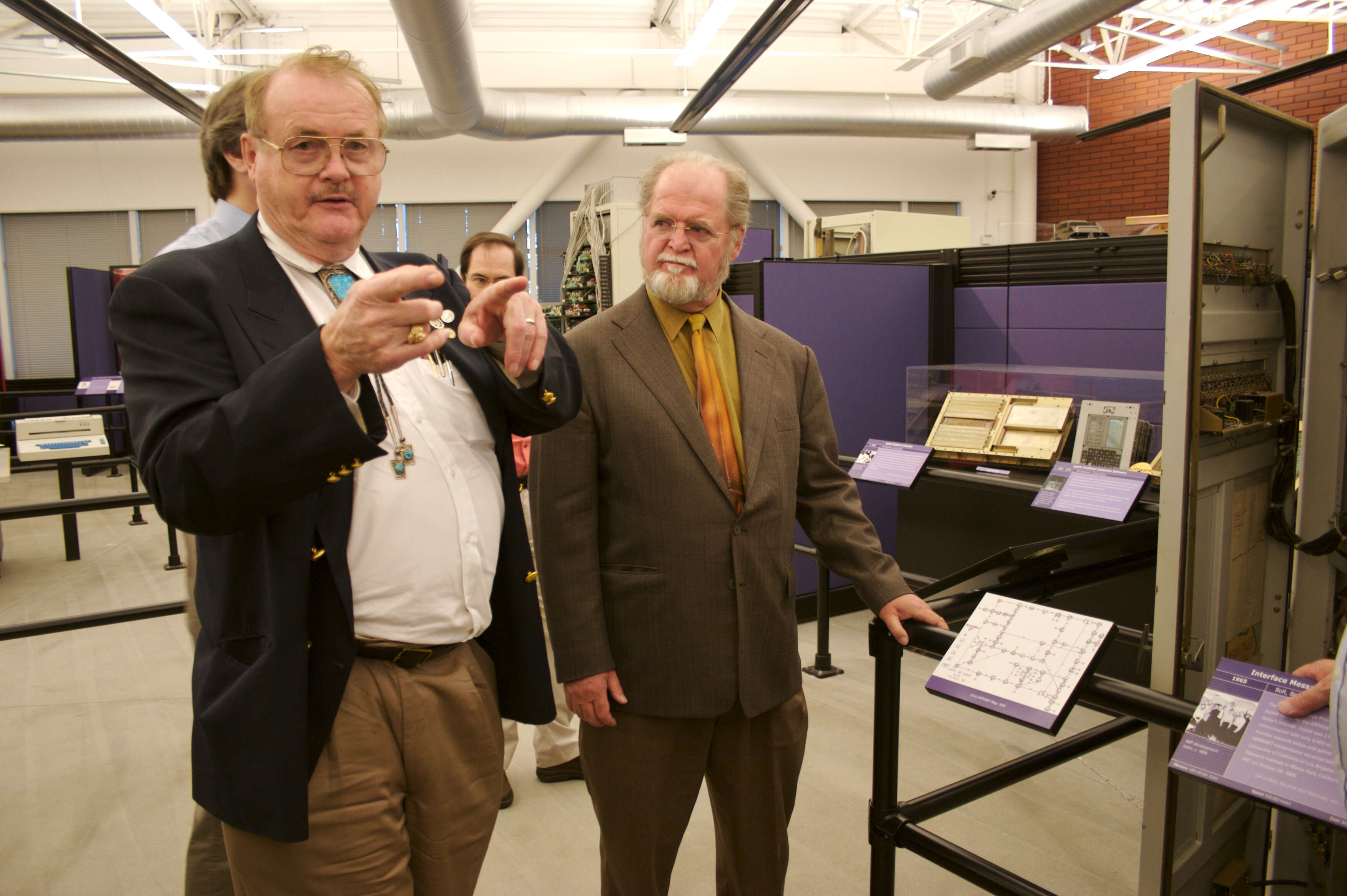
How Two Sci-Fi Writers Fueled a U.S. President's Wild Quest to Weaponize Space
On March 23, 1983, President Ronald Reagan made an audacious announcement: America would weaponize space.
This was no idle threat. Reagan had built his political reputation on tough-talking the Soviet Union, and during a time in the Cold War when intercontinental ballistic missiles (ICBMs) made shooting a nuclear warhead from Russia to major American cities a realistic threat, any new military technology could mean gaining the upper hand in a decades-long struggle that seemed ready to move beyond terrestrial limits. The Russians had just put gun turrets on their space stations. Granted, they'd only been fired once, and at nothing in particular. But we had to ready our retaliation.
The response was the Strategic Defense Initiative, a plan that would put in place a system of satellites to shoot ICBMs out of the sky as a nuclear deterrent from above. It would have been an expensive undertaking, to say the least, clocking in at anywhere from $100 billion to $1 trillion.
Within a few years, however, the program became the butt of jokes in Washington, even turning some in the president's own party against him. Jacob Javits, a Republican senator from New York, wrote in a 1986 New York Times op-ed, "The same public opinion that brought [President Reagan] to change his tone in dealing with the Soviet Union should now bring him to keep his original promise and thus remove the obstacles to peace posed by his Strategic Defense Initiative."
Bill Clinton renamed the Strategic Defense Initiative Organization the Ballistic Missile Defense Organization in 1993, fundamentally changing its mission and scale. But by then, the SDI was almost exclusively known by its derisive epithet of "Star Wars," an expensive government gamble on an idea that sounded a lot more like science-fiction than reality.
That's because it was. Behind Cold War weapons and strategies, decades of debate over space warfare, and the modern National Space Council -- recently revived by Vice President Mike Pence to remind the world that Earth's exosphere is a national security asset -- is the speculative, ideology-fueled fantasy of two famed science-fiction authors with the imaginations to dream of creating real-life laser guns and space missiles.

Larry Niven had the mind for space. An award-winning and best-selling author, his first installment of the Ringworld series -- a futuristic and sometimes tongue-in-cheek saga about a massive space station that orbits a distant star as an artificial planet -- was considered an instant classic. The book still remains one of the most popular of the several dozen he's published, and he continues to flesh out the series.
But in 1980, Niven took a career detour. Soon after the election, the author hosted a group of colleagues for a meeting at his home to discuss President-elect Reagan's stance on space. The "Citizens' Advisory Council on National Space Policy" included mostly right-leaning military figures, ex-astronauts, scientists, plus a number of Niven's science-fiction writer contemporaries. The group had the backing of the American Astronautical Society and the L-5 Society, both of which hoped to chart the course of the United States' space interests over the next two decades, with the more immediate goal of building its recommendations into Reagan's official policies.
In attendance was Jerry Pournelle, Niven’s co-author on both the 1974 book The Mote in God's Eye -- about a worst-case-scenario alien invasion -- and 1977's Lucifer's Hammer -- about a comet impact that creates widespread anarchy. A self-described centrist -- but only in terms of his own elaborate political mapping system, the Pournelle Axes -- Pournelle believed in a robust, technocratic military state wedged between the New Left and conservative factions of government.
By Reagan's inauguration, Pournelle already had a long and successful career blending his fiction writing with real-life world-building, usually within the framework of American Cold War military deterrence. With degrees in psychology and political science, Pournelle did not limit himself to fictional writing; he authored a paper for the Air Force on stability's role in national security, which spends a good deal of time on technology's place in an international arms race. He developed this concept even more in a later work, which further demonstrated Pournelle's belief that technology should be viewed through a militaristic prism.
To Pournelle, it seemed natural that America should extend its terrestrial military force and technological advancement into the great beyond. While working for Boeing in the 1950s, he developed the concept of "Rods from God," giant tungsten tubes that could be dropped on targets from space to create massive destruction without the use of nuclear arms, or any explosives, for that matter. The New York Timesdescribed Pournelle in 2006 as "a science-fiction writer and space-weapons expert," before going on to say the rods were included in a George W. Bush-era Air Force plan for space-based weapons, despite the known impracticality of funding and constructing rockets powerful enough to launch the heavy rods into space.
Reagan's search for space-based options to enhance America's military had context prompted the Citizens' Advisory Council on National Space Policy to convene at Niven's house. Pournelle chaired the meeting, and the result of a three-day weekend was an ominously titled document: "Space: The Crucial Frontier."
Pournelle's preamble for the policy, published in 1981, calls space "our most valuable natural resource" and a place that opens up "significant and possibly decisive military and economic advantages."
"We worked all weekend and produced a paper for the transition team, then at the president's request we started in on a plan for after inauguration at another meeting," Pournelle wrote on his blog. "The president read the full reports, which strongly recommended Strategic Defense. In 1983 he made his Star Wars speech. It included several phrases from the Council reports."
What did the president find that was so appealing?

Outer space offers the ultimate blank canvas for political ideologies, untainted as it is by human inhabitants and their attendant beliefs. Niven and Pournelle saw an opportunity to shape the great void in their political image, and Reagan viewed space as yet another tool to defend America against the communist superpower on the other side of the world. "What if free people could live secure in the knowledge that their security did not rest upon the threat of instant US retaliation to deter a Soviet attack, that we could intercept and destroy strategic ballistic missiles before they reached our own soil or that of our allies?" the president asked in his speech announcing the SDI.
The two writers of the report on which Reagan based the SDI were politically on board. "I'm sort of right-of-center Libertarian," Niven later described in a 2011 interview with Republibot. "I want a government for things like roads and bridges. Beyond that, the government has been growing like kudzu, once an ornamental garden plant." In an email to Thrillist, Pournelle describes himself as a "Cold Warrior as much as anything," further stating, "We took the Cold War seriously in those days. That pretty well governed my political views then."
The Reagan administration appreciated the viewpoints of the Citizens' Advisory Council on National Space Policy, which also included a man who would become a driving force behind SDI: Lt. General David O. Graham. "It was a natural alliance, and Strategic Defense became -- with commercial space -- a cornerstone of our policy recommendations for Reagan," Pournelle tells me.
"A vigorous space program is necessary for national security. Both military and commercial aspects of space are vital to US national interests," the authors wrote in "Space: The Crucial Frontier." "Military weapons in space can be strategically decisive before 1990, and the economic resources of space will become increasingly important before the end of the century."
Niven and Pournelle also outlined a more intimate union between NASA and the military.
"Although many space missions are clearly military, it is unreasonable to create artificial barriers between 'military' and 'civilian' programs," the document states. "Nearly all activities in space gather experience which can be valuable to future military and economic missions. It is impossible to specify in advance which space activities will be required by military considerations. It is therefore necessary that we expand nearly all space capabilities."

"The Crucial Frontier" is scattered with forward-thinking touchstones, including large-scale power production in space and permanent space stations in low-Earth orbit designed to foster asteroid-mining initiatives. There's also a proposed flyby of Halley's Comet and a reexamination of space treaties, with an eye toward resource exploitation on the moon. In fact, there's a call for total withdrawal of all space treaties -- especially those that restrict space weapons. In essence, the plan was simply to propel right-wing American agendas off Earth: extract resources and build military might.
"Our share of extraterrestrial resources would enormously increase our military strength. This in turn would give weight to your [President Reagan's] diplomacy in its quest for a genuine peace."
Being futurists, the group also identified what it believed to be incoming, technological threats: death rays from space, either taking the form of lasers (which use concentrated photon beams) or mass weapons (a stream of electrons). The report notes that while no one had actually launched these weapons into space, versions of them had been used with varying success on Earth, which meant it was only a matter of time before lasers from space started wreaking havoc in the wars of tomorrow.
"Deployed in high Earth orbit, one such station could potentially burn down all the missiles launched from whatever locations by one side during an all-out nuclear war, and then leisurely burn down all enemy bombers for an encore," the report states, going on to say that such a giant space death ray could assure victory and deflect any attack. "If such a space laser battle station could defend itself from all types of attack which enemies of its owners could direct against it, its ownership would confer the prize of a planet -- just as soon as it was put into orbit."
The document goes on to mention the ability of the Soviets to put large payloads into low Earth orbit, a capability the United States didn't readily have in 1980, and raises concerns about supposed "killer satellites" the authors claimed wielded space shotguns to deorbit satellites.
"Advanced reconnaissance satellites may contribute significantly to the stabilization of peace between the superpowers in the late '80s and '90s, if war-waging capabilities become comparable in that period," the space war portion of the report concludes. "These satellites will be valuable, but vulnerable. Space defenses are possible, but only for those who have a presence in space. US space capabilities may therefore be crucial for US survival."
It seemed like Star Wars might just be America's ticket to extraterrestrial domination.
In 1984, the US made its first show of strength beyond Earth when one US missile supposedly sought out another in space and annihilated the practice run threat. It seemed like Star Wars might just be America's ticket to extraterrestrial domination.
Except it was a completely fabricated moment. After three unsuccessful attempts, the United States' fourth mission switched from having one missile target the other to making the missiles hone in on each other, communicating their relative positions back and forth until they intercepted each other. This was revealed in a 1993 New York Times investigation, and was supposedly designed to convince Congress to inject more money into the program through deceit.
And even though right-leaning factions were riding high on Reaganism, they were far from the only voices crossing over from science fiction to politics. While Pournelle, Niven, and their associates favored a program like Star Wars, sci-fi authors Arthur C. Clarke and Isaac Asimov spoke out forcefully against it, and in much more clairvoyant terms. "I don't think Star Wars is feasible and I don't think anyone takes it seriously. It's just a device to make the Russians go broke. But we'll go broke, too. It's very much a John Wayne standoff," Asimov told the Chicago Tribune in a 1985 interview, while Clarke called some of the plans "technological obscenities." Still, 30 years later, Pournelle defended the SDI.
"The first benefit of SDI was that it eliminated the threat of a mad dictator -- or a mad defecting general -- with a missile or two," he wrote on his blog. "That sort of attack could be 100% intercepted, simplifying foreign policy."
If only it had ever actually existed.

Like the movie franchise, the Star Wars defense system and its spinoffs simply won't die. Niven and Pournelle's legacy lives on in their recommendation to increase private space investment, an echo of the Reagan administration's belief in free-market solutionism. The shift away from government initiatives to private ventures has rippled through virtually every industry, and as NASA loses funding and influence, companies like Elon Musk's Space X and Jeff Bezos' Blue Origin are racing to find ways to turn space into a profitable expanse.
Space conversations tend to repeat themselves when actual spaceflight moves at a more sluggish pace than the imagination. Even Elon Musk's grandest comments echo what every “New Space" futurist is searching for: a reusable rocket, an asteroid to mine, a tourist visa to the stars, or a way to get to Mars.
In government circles, "The Crucial Frontier" fits as well in 2017 as it did in 1980. Space tourism is a friendly enough concept and all, but there's also renewed talks of military engagement in space. In his recent address to the National Space Council, Vice President Pence (who has been deputized on all space matters, seemingly) spoke of the Trump administration's desire to return to the moon... and a lot about the military in space.
"According to the U. Intelligence Community, Russia and China are pursuing a full range of anti-satellite technology to reduce US military effectiveness, and they’re increasingly considering attacks against satellite systems as part of their future warfare doctrine," said Pence at the October 5 session. "Just as with Sputnik six decades ago, we have resolved, with the leadership of President Donald Trump, to never again let America fall behind in the race for space."
Altering a few words in the original 1980 document could easily make it echo the current administration's response about any of the nuclear states we currently consider foreign enemies. And we're closer to a modern Star Wars than you might realize: In June 2017, the US House Armed Services Committee voted to include language that would add the "US Space Corps" to the 2018 National Defense Authorization Act, establishing America's first space-centric branch of the military.

In his speech, Pence didn't go so far as to announce a bold program like Star Wars, but the right-wing sci-fi writers who deeply influenced the policies of the '80s are happy to offer their expertise today, since virtually any national security effort seeks out innovative military strategies that need not have grounding in reality. In the years following 9/11, as George W. Bush surrounded himself with wonks from the Soviet era to wage a new war on terror, a familiar group of sci-fi authors joined the ranks. Calling themselves Sigma, writers -- including Pournelle and Niven -- found themselves advising the Department of Homeland Security on technological strategies for defeating terrorist threats.
One Sigma member, Arlan Andrews, told USA Today in 2007, "We spend our entire careers living in the future," while Pournelle called the group "well-qualified nuts," without mentioning, of course, that the writers' proposals over the preceding decades were monetarily out of reach. With the fundamental character of America left virtually intact -- subbing in new enemies, new leaders, and new technologies on top of a still-underdeveloped space program -- the same creative minds who cooked up Star Wars in the 1980s continue to reinvent their ideas for the current context. What remains to be seen is whether they can influence official policy with the same success and imagination they had during the Cold War.
Sign up here for our daily Thrillist email and subscribe here for our YouTube channel to get your fix of the best in food/drink/fun.

